2006 TOYOTA RAV4 ignition
[x] Cancel search: ignitionPage 1676 of 2000

SUPPLEMENTAL RESTRAINT SYSTEM – AIRBAG SYSTEMRS–27
RS
• The center airbag sensor receives signals
from the deceleration sensor and the
electronic safing sensor built into the center
airbag sensor and the rear airbag sensor, and
determines whether or not the side airbag
and curtain shield airbag should be activated,
and diagnoses system malfunctions.
• The center airbag sensor sends the airbag
deployment signal to ECM through the CAN
to operate the fuel pump control.
(2) Deceleration sensor and ignition control circuit
• The deceleration sensor is built into the
center airbag sensor.
• The ignition control circuit performs
calculations based on the signal output from
the deceleration sensors of the center airbag
sensor and front airbag sensor. If the
calculated values are greater than the
specified values, it activates the deployment
operation.
(3) Safing sensor
The safing sensor is built into the center airbag
sensor. During a frontal collision, the sensor
turns on and outputs an ON signal to the center
airbag sensor if a deceleration rate greater than
the specified value is applied to the safing
sensor.
(4) Electronic safing sensor
The electronic safing sensor is built into the
center airbag sensor. During a side collision, the
sensor turns on and outputs an ON signal to the
center airbag sensor if a deceleration rate
greater than the specified value is applied to the
electronic safing sensor.
(5) Back-up power source
The back-up power source consists of a power
supply capacitor and a DC-DC converter. When
the power system does not function during a
collision, the power supply capacitor discharges
and supplies electric power to the system. The
DC-DC converter operates as a boosting
transformer when the battery voltage falls below
a predetermined level.
(6) Diagnostic circuit
This circuit constantly diagnoses system
malfunctions. When a malfunction is detected, it
lights up the SRS warning light on the telltale
light to inform the driver.
(7) Memory circuit
When a malfunction is detected in the diagnostic
circuit, it is coded and stored in the memory
circuit.
Page 1677 of 2000
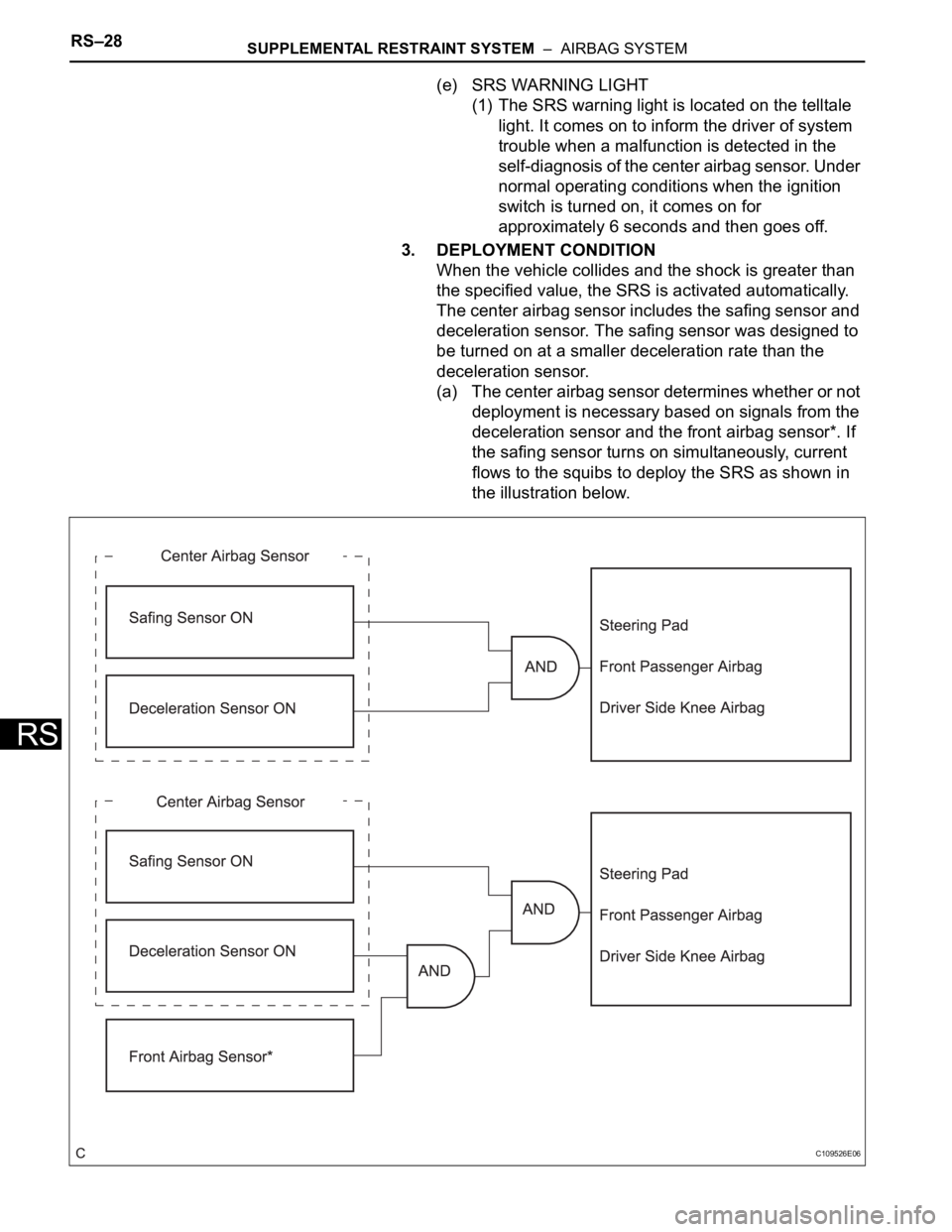
RS–28SUPPLEMENTAL RESTRAINT SYSTEM – AIRBAG SYSTEM
RS
(e) SRS WARNING LIGHT
(1) The SRS warning light is located on the telltale
light. It comes on to inform the driver of system
trouble when a malfunction is detected in the
self-diagnosis of the center airbag sensor. Under
normal operating conditions when the ignition
switch is turned on, it comes on for
approximately 6 seconds and then goes off.
3. DEPLOYMENT CONDITION
When the vehicle collides and the shock is greater than
the specified value, the SRS is activated automatically.
The center airbag sensor includes the safing sensor and
deceleration sensor. The safing sensor was designed to
be turned on at a smaller deceleration rate than the
deceleration sensor.
(a) The center airbag sensor determines whether or not
deployment is necessary based on signals from the
deceleration sensor and the front airbag sensor*. If
the safing sensor turns on simultaneously, current
flows to the squibs to deploy the SRS as shown in
the illustration below.
C109526E06
Page 1678 of 2000
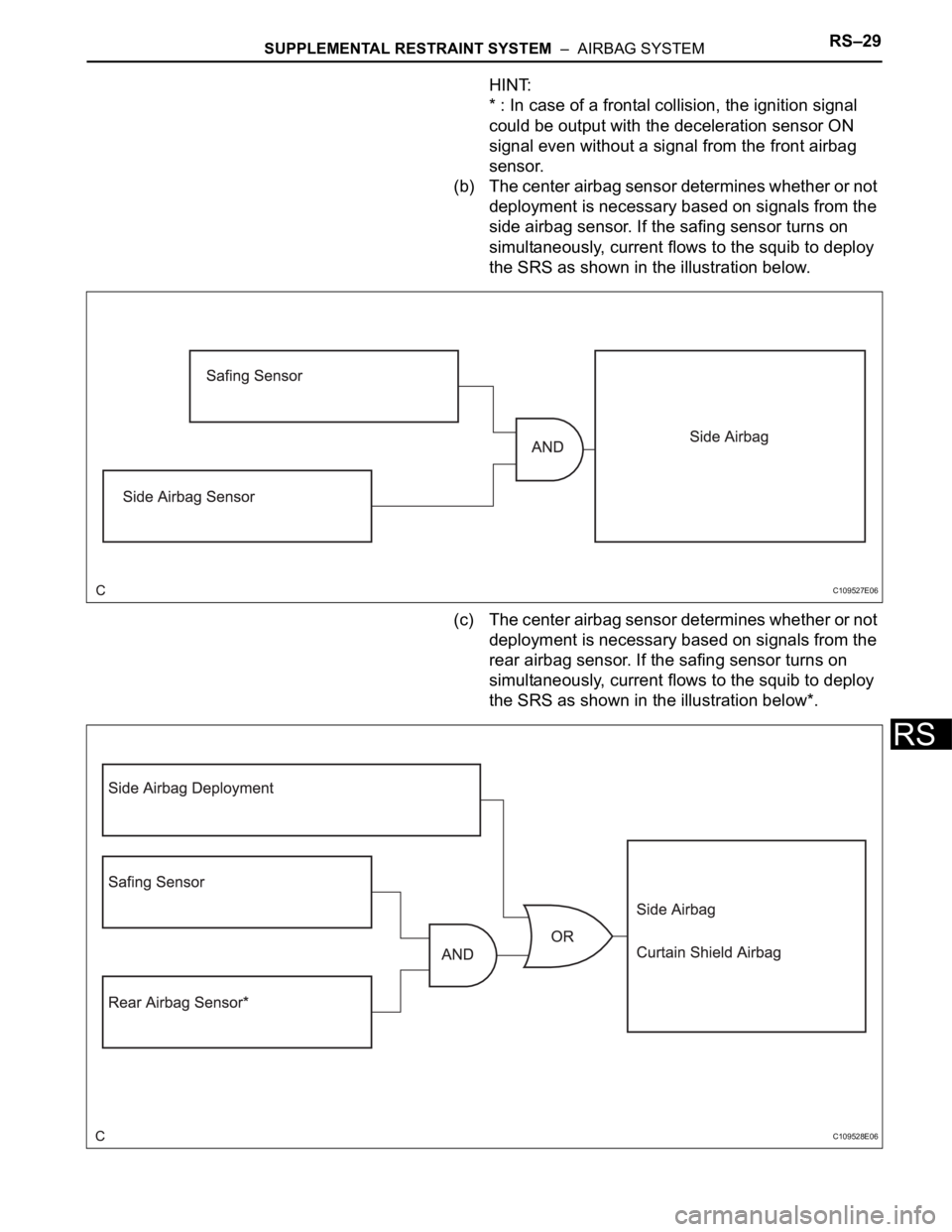
SUPPLEMENTAL RESTRAINT SYSTEM – AIRBAG SYSTEMRS–29
RS
HINT:
* : In case of a frontal collision, the ignition signal
could be output with the deceleration sensor ON
signal even without a signal from the front airbag
sensor.
(b) The center airbag sensor determines whether or not
deployment is necessary based on signals from the
side airbag sensor. If the safing sensor turns on
simultaneously, current flows to the squib to deploy
the SRS as shown in the illustration below.
(c) The center airbag sensor determines whether or not
deployment is necessary based on signals from the
rear airbag sensor. If the safing sensor turns on
simultaneously, current flows to the squib to deploy
the SRS as shown in the illustration below*.
C109527E06
C109528E06
Page 1684 of 2000
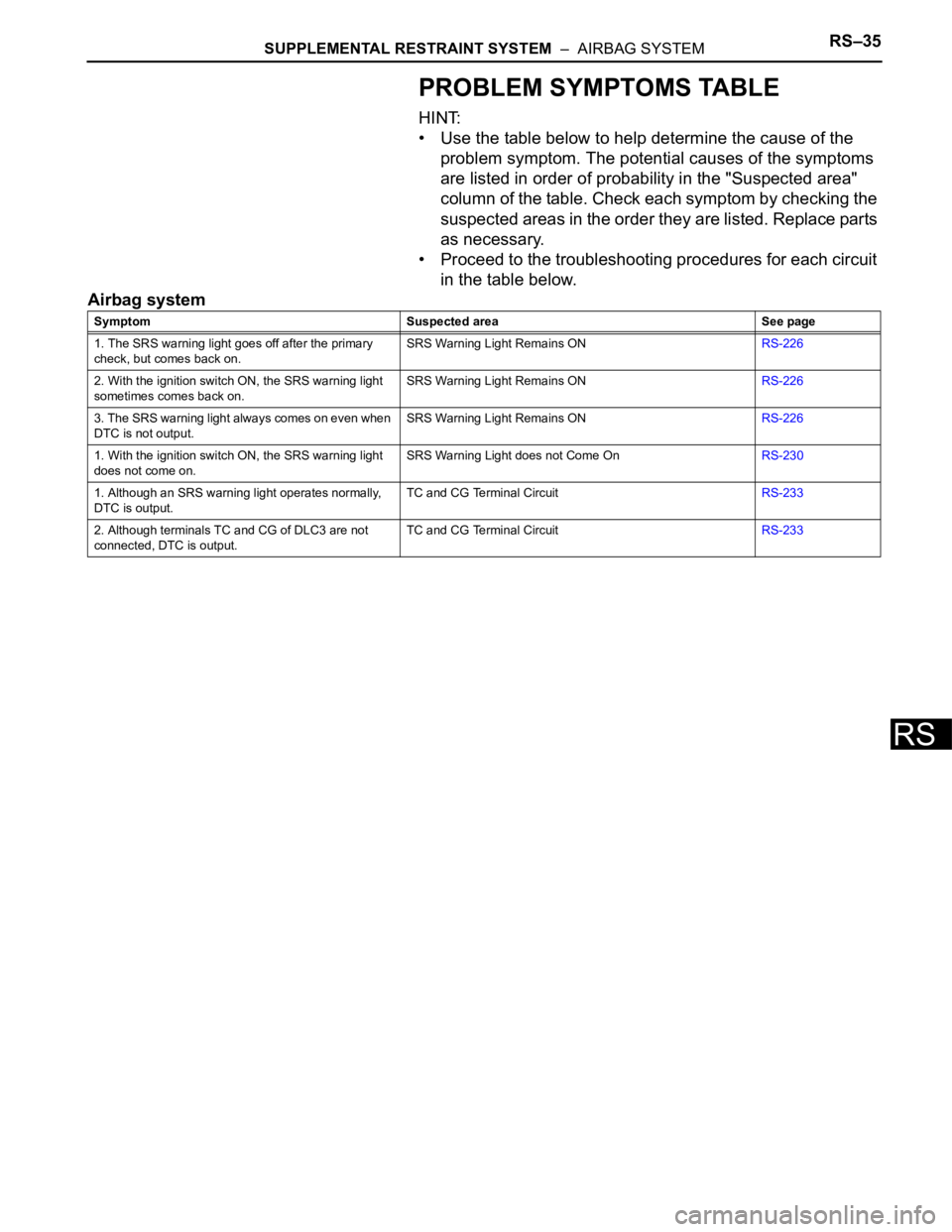
SUPPLEMENTAL RESTRAINT SYSTEM – AIRBAG SYSTEMRS–35
RS
PROBLEM SYMPTOMS TABLE
HINT:
• Use the table below to help determine the cause of the
problem symptom. The potential causes of the symptoms
are listed in order of probability in the "Suspected area"
column of the table. Check each symptom by checking the
suspected areas in the order they are listed. Replace parts
as necessary.
• Proceed to the troubleshooting procedures for each circuit
in the table below.
Airbag system
Symptom Suspected area See page
1. The SRS warning light goes off after the primary
check, but comes back on.SRS Warning Light Remains ONRS-226
2. With the ignition switch ON, the SRS warning light
sometimes comes back on.SRS Warning Light Remains ONRS-226
3. The SRS warning light always comes on even when
DTC is not output.SRS Warning Light Remains ONRS-226
1. With the ignition switch ON, the SRS warning light
does not come on.SRS Warning Light does not Come OnRS-230
1. Although an SRS warning light operates normally,
DTC is output.TC and CG Terminal CircuitRS-233
2. Although terminals TC and CG of DLC3 are not
connected, DTC is output.TC and CG Terminal CircuitRS-233
Page 1688 of 2000
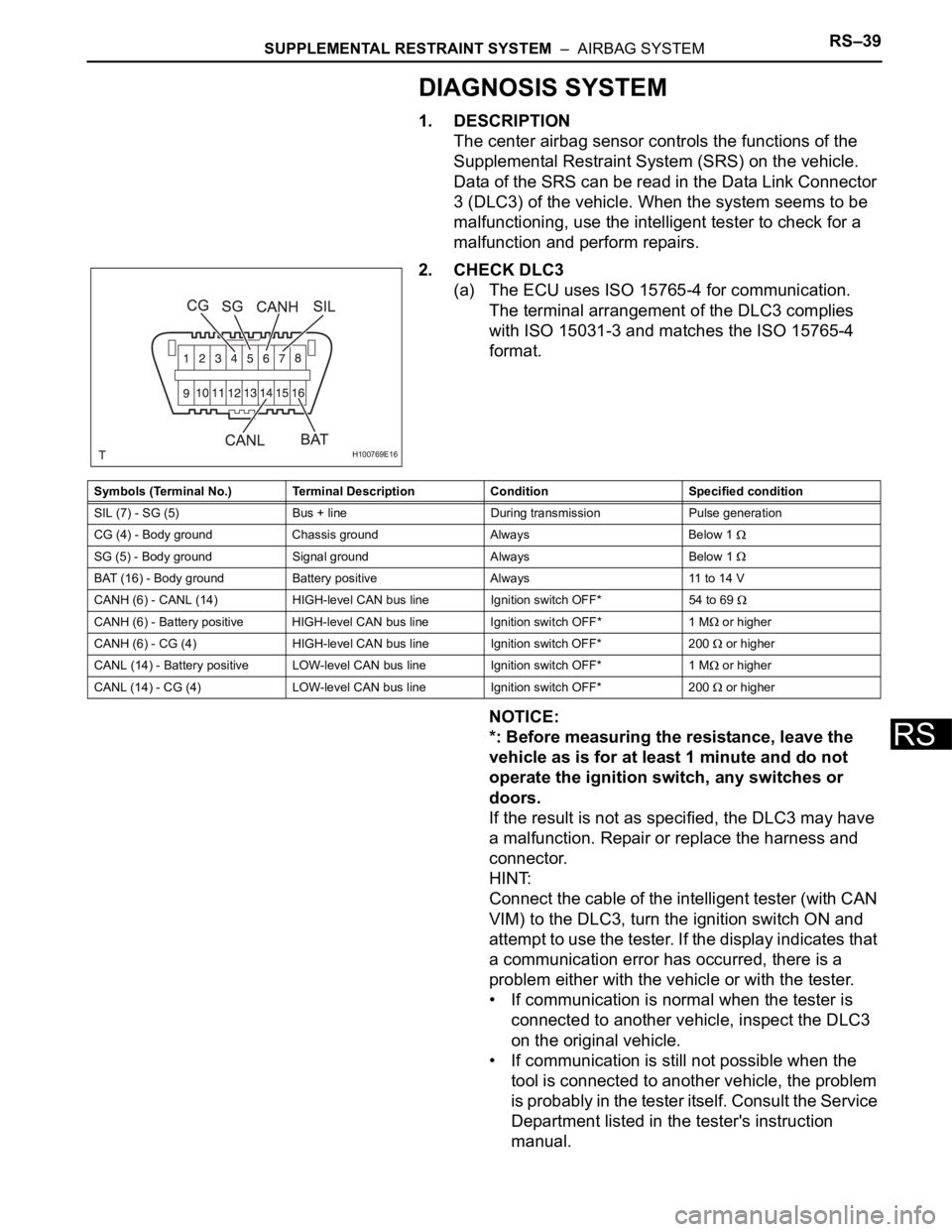
SUPPLEMENTAL RESTRAINT SYSTEM – AIRBAG SYSTEMRS–39
RS
DIAGNOSIS SYSTEM
1. DESCRIPTION
The center airbag sensor controls the functions of the
Supplemental Restraint System (SRS) on the vehicle.
Data of the SRS can be read in the Data Link Connector
3 (DLC3) of the vehicle. When the system seems to be
malfunctioning, use the intelligent tester to check for a
malfunction and perform repairs.
2. CHECK DLC3
(a) The ECU uses ISO 15765-4 for communication.
The terminal arrangement of the DLC3 complies
with ISO 15031-3 and matches the ISO 15765-4
format.
NOTICE:
*: Before measuring the resistance, leave the
vehicle as is for at least 1 minute and do not
operate the ignition switch, any switches or
doors.
If the result is not as specified, the DLC3 may have
a malfunction. Repair or replace the harness and
connector.
HINT:
Connect the cable of the intelligent tester (with CAN
VIM) to the DLC3, turn the ignition switch ON and
attempt to use the tester. If the display indicates that
a communication error has occurred, there is a
problem either with the vehicle or with the tester.
• If communication is normal when the tester is
connected to another vehicle, inspect the DLC3
on the original vehicle.
• If communication is still not possible when the
tool is connected to another vehicle, the problem
is probably in the tester itself. Consult the Service
Department listed in the tester's instruction
manual.
H100769E16
Symbols (Terminal No.) Terminal Description Condition Specified condition
SIL (7) - SG (5) Bus + line During transmission Pulse generation
CG (4) - Body ground Chassis ground Always Below 1
SG (5) - Body ground Signal ground Always Below 1
BAT (16) - Body ground Battery positive Always 11 to 14 V
CANH (6) - CANL (14) HIGH-level CAN bus line Ignition switch OFF*54 to 69
CANH (6) - Battery positive HIGH-level CAN bus line Ignition switch OFF* 1 M or higher
CANH (6) - CG (4) HIGH-level CAN bus line Ignition switch OFF* 200
or higher
CANL (14) - Battery positive LOW-level CAN bus line Ignition switch OFF* 1 M
or higher
CANL (14) - CG (4) LOW-level CAN bus line Ignition switch OFF* 200
or higher
Page 1689 of 2000
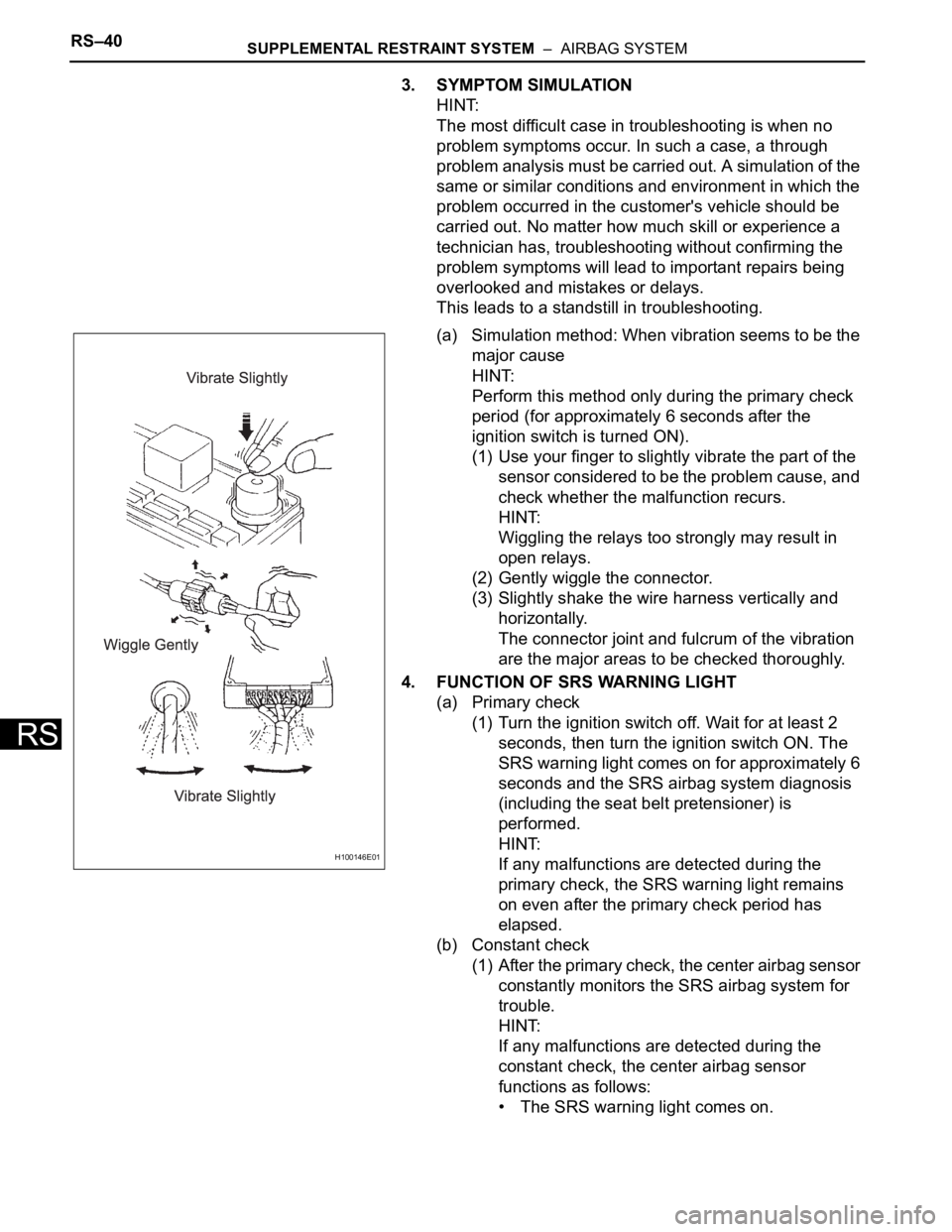
RS–40SUPPLEMENTAL RESTRAINT SYSTEM – AIRBAG SYSTEM
RS
3. SYMPTOM SIMULATION
HINT:
The most difficult case in troubleshooting is when no
problem symptoms occur. In such a case, a through
problem analysis must be carried out. A simulation of the
same or similar conditions and environment in which the
problem occurred in the customer's vehicle should be
carried out. No matter how much skill or experience a
technician has, troubleshooting without confirming the
problem symptoms will lead to important repairs being
overlooked and mistakes or delays.
This leads to a standstill in troubleshooting.
(a) Simulation method: When vibration seems to be the
major cause
HINT:
Perform this method only during the primary check
period (for approximately 6 seconds after the
ignition switch is turned ON).
(1) Use your finger to slightly vibrate the part of the
sensor considered to be the problem cause, and
check whether the malfunction recurs.
HINT:
Wiggling the relays too strongly may result in
open relays.
(2) Gently wiggle the connector.
(3) Slightly shake the wire harness vertically and
horizontally.
The connector joint and fulcrum of the vibration
are the major areas to be checked thoroughly.
4. FUNCTION OF SRS WARNING LIGHT
(a) Primary check
(1) Turn the ignition switch off. Wait for at least 2
seconds, then turn the ignition switch ON. The
SRS warning light comes on for approximately 6
seconds and the SRS airbag system diagnosis
(including the seat belt pretensioner) is
performed.
HINT:
If any malfunctions are detected during the
primary check, the SRS warning light remains
on even after the primary check period has
elapsed.
(b) Constant check
(1) After the primary check, the center airbag sensor
constantly monitors the SRS airbag system for
trouble.
HINT:
If any malfunctions are detected during the
constant check, the center airbag sensor
functions as follows:
• The SRS warning light comes on.
H100146E01
Page 1690 of 2000
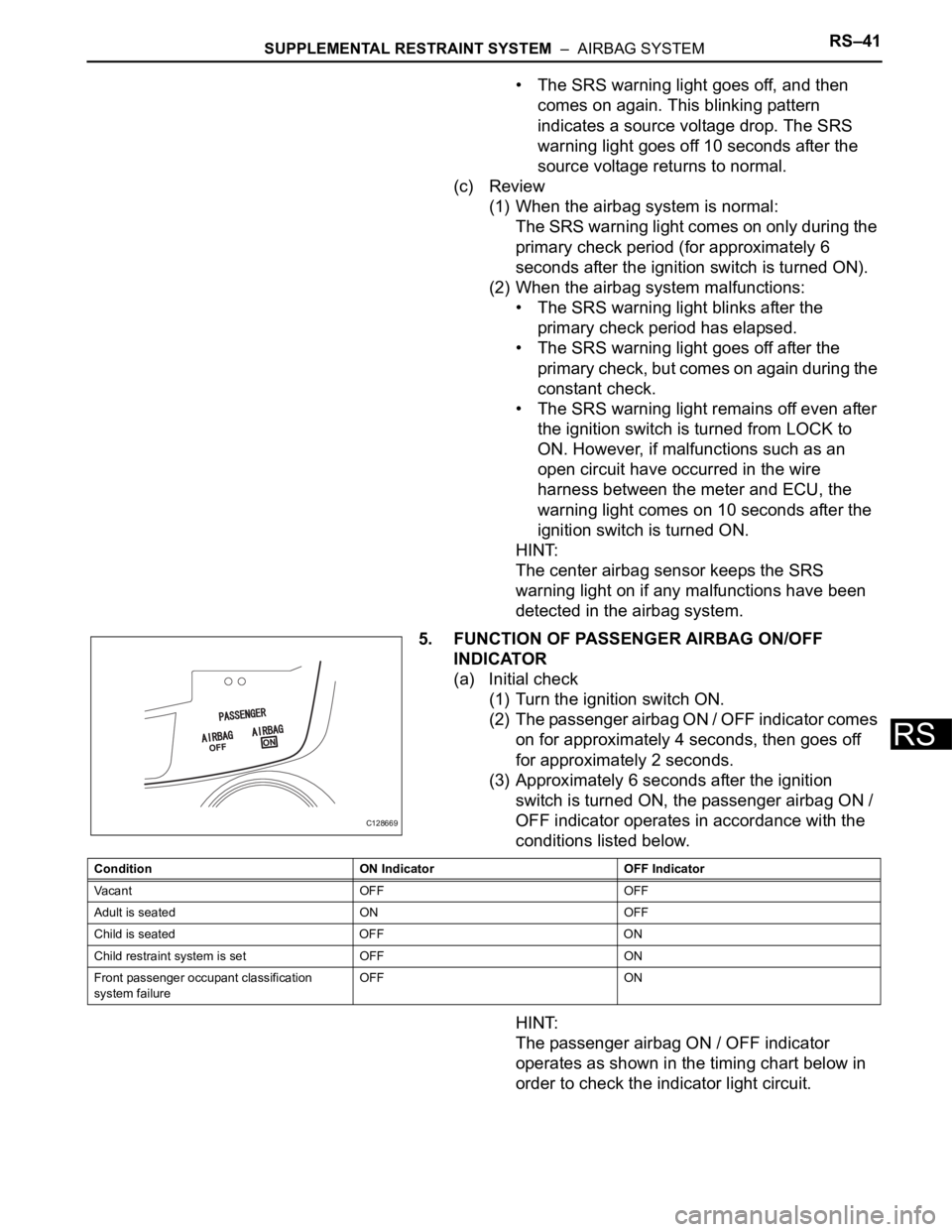
SUPPLEMENTAL RESTRAINT SYSTEM – AIRBAG SYSTEMRS–41
RS
• The SRS warning light goes off, and then
comes on again. This blinking pattern
indicates a source voltage drop. The SRS
warning light goes off 10 seconds after the
source voltage returns to normal.
(c) Review
(1) When the airbag system is normal:
The SRS warning light comes on only during the
primary check period (for approximately 6
seconds after the ignition switch is turned ON).
(2) When the airbag system malfunctions:
• The SRS warning light blinks after the
primary check period has elapsed.
• The SRS warning light goes off after the
primary check, but comes on again during the
constant check.
• The SRS warning light remains off even after
the ignition switch is turned from LOCK to
ON. However, if malfunctions such as an
open circuit have occurred in the wire
harness between the meter and ECU, the
warning light comes on 10 seconds after the
ignition switch is turned ON.
HINT:
The center airbag sensor keeps the SRS
warning light on if any malfunctions have been
detected in the airbag system.
5. FUNCTION OF PASSENGER AIRBAG ON/OFF
INDICATOR
(a) Initial check
(1) Turn the ignition switch ON.
(2) The passenger airbag ON / OFF indicator comes
on for approximately 4 seconds, then goes off
for approximately 2 seconds.
(3) Approximately 6 seconds after the ignition
switch is turned ON, the passenger airbag ON /
OFF indicator operates in accordance with the
conditions listed below.
HINT:
The passenger airbag ON / OFF indicator
operates as shown in the timing chart below in
order to check the indicator light circuit.
C128669
Condition ON Indicator OFF Indicator
Va c a n t O F F O F F
Adult is seated ON OFF
Child is seated OFF ON
Child restraint system is set OFF ON
Front passenger occupant classification
system failureOFF ON
Page 1691 of 2000
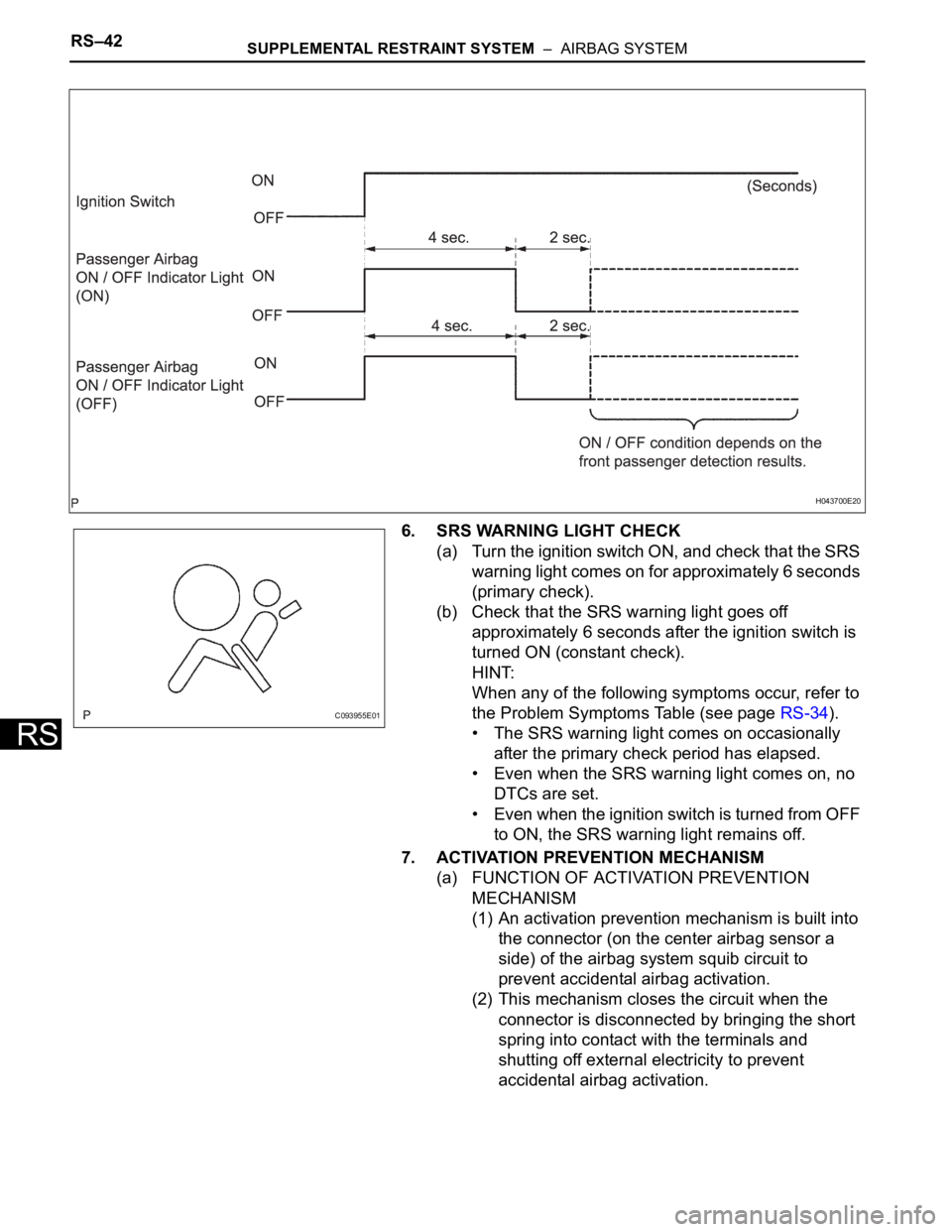
RS–42SUPPLEMENTAL RESTRAINT SYSTEM – AIRBAG SYSTEM
RS
6. SRS WARNING LIGHT CHECK
(a) Turn the ignition switch ON, and check that the SRS
warning light comes on for approximately 6 seconds
(primary check).
(b) Check that the SRS warning light goes off
approximately 6 seconds after the ignition switch is
turned ON (constant check).
HINT:
When any of the following symptoms occur, refer to
the Problem Symptoms Table (see page RS-34).
• The SRS warning light comes on occasionally
after the primary check period has elapsed.
• Even when the SRS warning light comes on, no
DTCs are set.
• Even when the ignition switch is turned from OFF
to ON, the SRS warning light remains off.
7. ACTIVATION PREVENTION MECHANISM
(a) FUNCTION OF ACTIVATION PREVENTION
MECHANISM
(1) An activation prevention mechanism is built into
the connector (on the center airbag sensor a
side) of the airbag system squib circuit to
prevent accidental airbag activation.
(2) This mechanism closes the circuit when the
connector is disconnected by bringing the short
spring into contact with the terminals and
shutting off external electricity to prevent
accidental airbag activation.
H043700E20
C093955E01